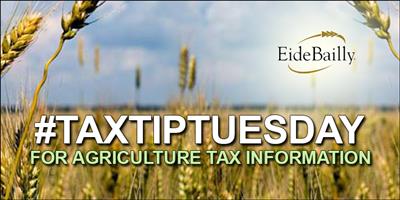Have you ever thought about paying your farm and ranch employees in commodities like grain, hay or even calves? It can be a very useful tax savings tool and there are several good reasons why you should look into it
Wages paid in commodities are exempt from social security and Medicare tax for both employee and employer. Agricultural wages paid in commodities can be a very useful tax savings tool in paying farm wages to your spouse, children over age 18, or any other employees who are subject to FICA tax withholding rules. The main advantage is that the paying of wages in commodities is exempt from social security and Medicare tax for both the employee and employer. In addition, wages paid in commodities are not subject to the federal income tax withholding rules otherwise required.
If a farmer would choose to pay his employee in cash, the employer would be required to withhold social security and Medicare tax from the employee and, as employer, would also have to match this amount. If, on the other hand, the farmer had paid the wages in commodities instead of cash, he would have been relieved of any social security and Medicare tax, thus a savings to both the employee and the employer. The following example illustrates the savings.
If your spouse was your employee and payment was made in commodities, you would save both the employee’s and employer’s portion of social security and Medicare tax or $612.
If you want to implement this tax savings idea, it would be advisable to follow the guidelines which are outlined in the “Market Segment Understanding – Guidelines forAgricultural Labor – Noncash Renumeration,” issued by the IRS:
1. The wages must be paid for agricultural labor.
2. The employee must exercise dominion and control over the commodity.
a. This is a facts and circumstances test, and more weight is given to the substance of the transaction than the form of the transaction.
i. The employee must bear the economic risk associated with the ownership of the commodity received, and bear all costs of maintenance related to the commodity, such as storage, handling and maintenance after the transfer has taken place. Ideally, the employee would hold the commodities for two weeks or more before selling. This will indicate to the IRS that the employee had economic risk for the commodity. Cash Wages Wages Paid in Commodities $4000 $4000 Gross Pay to Employee $4000 $4000 Social Security and Medicare Tax Withheld $306 -0- Net Paid Employee $3694 $4000 Social Security and Medicare Taxes: Employees Share $306 -0- Employers Share $306 -0- $612 -0- An Independent Member Firm of HLB International Rev: 05/2013
ii. It is also advisable to assure that proper documentation of the transfer of title to the commodity has taken place. Employment contracts, assembly sheets, sales tickets, storage/warehouse receipts, etc. should all support the transfer of title to the employee.
iii. Farmer needs to be sure that commodities given to the employee are payment contract.
3. The payment must not be equivalent to cash.
a. The employer must transfer ownership of the commodity to the employee prior to the sale of the commodity by the employee.
b. Payments under a deferred contract are likely to be considered a cash equivalent, because the commodity had already been sold by the employer prior to transfer to the employee.
c. The longer the employee holds the commodity prior to converting to cash, the better. Preferably two to four weeks.
4. The employer must include the fair market value of the commodity transferred in the employee’s gross wages in box 1 of W-2. This is based on the commodity value at the time of transfer.
5. Income equal to the fair market value of the commodities at the time of transfer must be recognized by the employee.
6. A deduction equal to the fair market value of the commodities at the time of transfer is allowed to the employer on Schedule F as wage expense. However, the value of the commodity shown on the employee’s W-2 must also be included on Schedule F as additional grain sales. This will show a net affect of zero income on the Schedule F, which is the outcome desired.
7. The employee will record the gain or loss on the commodity sold as a short-term capital gain or loss on the Schedule D in the year the employee sells the commodity. This gain or loss will be calculated as the difference between the fair market value of the commodity at the time received and the actual sales price.
The disadvantage of paying wages in commodities is that it does not credit the account of the employee for social security benefit purposes. The employer should ensure that the employee understands this. The employee may want to purchase their own disability insurance or begin saving for retirement.
The farmer/employer must make sure that the risk of ownership and marketing of the commodity is transferred to the employee. If this hasn’t been done, the IRS may rule that a true employer-employee relationship did not exist and you in effect have sold the grain yourself and paid the employee in cash, thus making you subject to the payroll tax withholding rules. It is also important to note that because the title to the commodity is transferred to the employee, and marketed by the employee, the employer will not receive any future patronage allocation related to the commodity sale.
Sponsored by Eide Bailly




